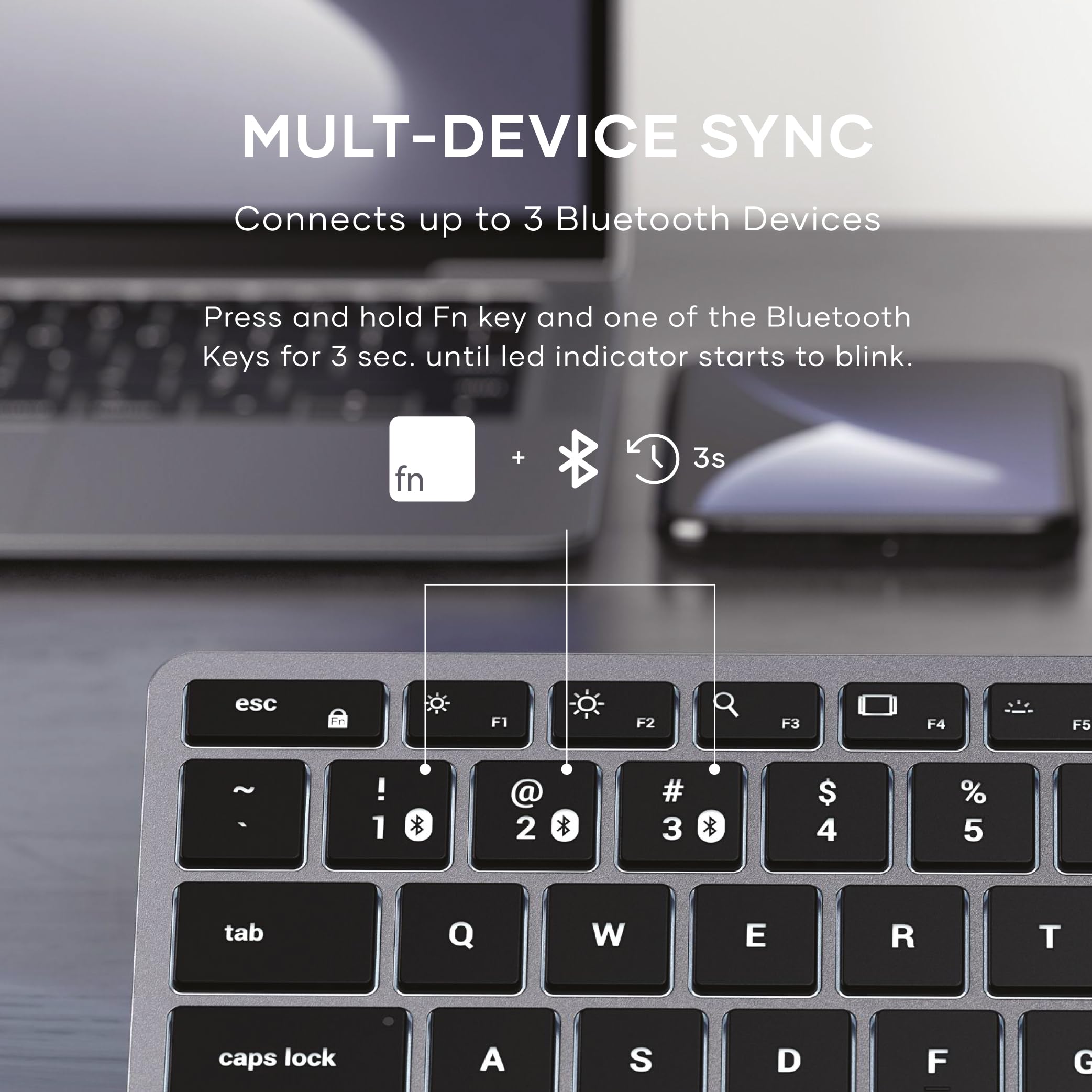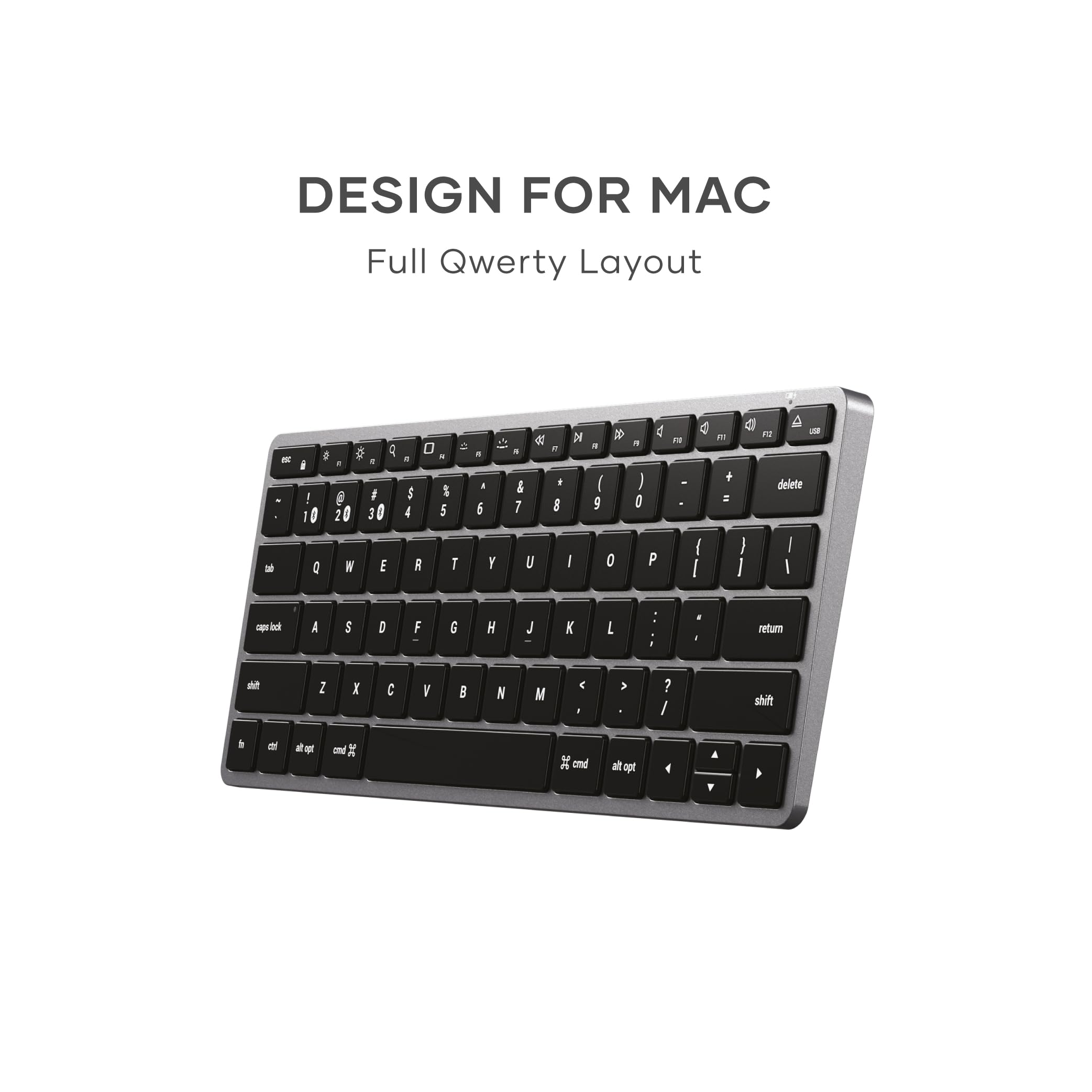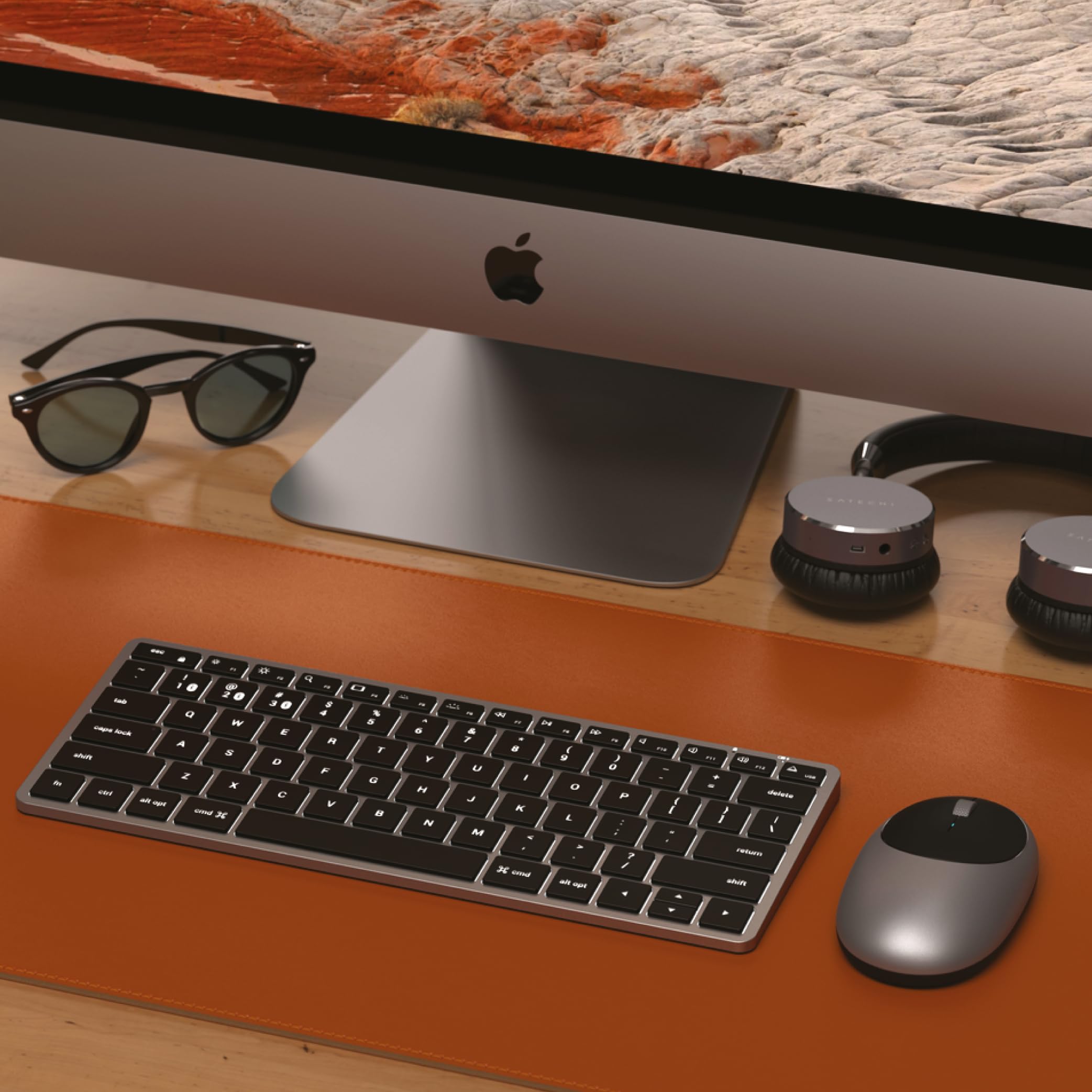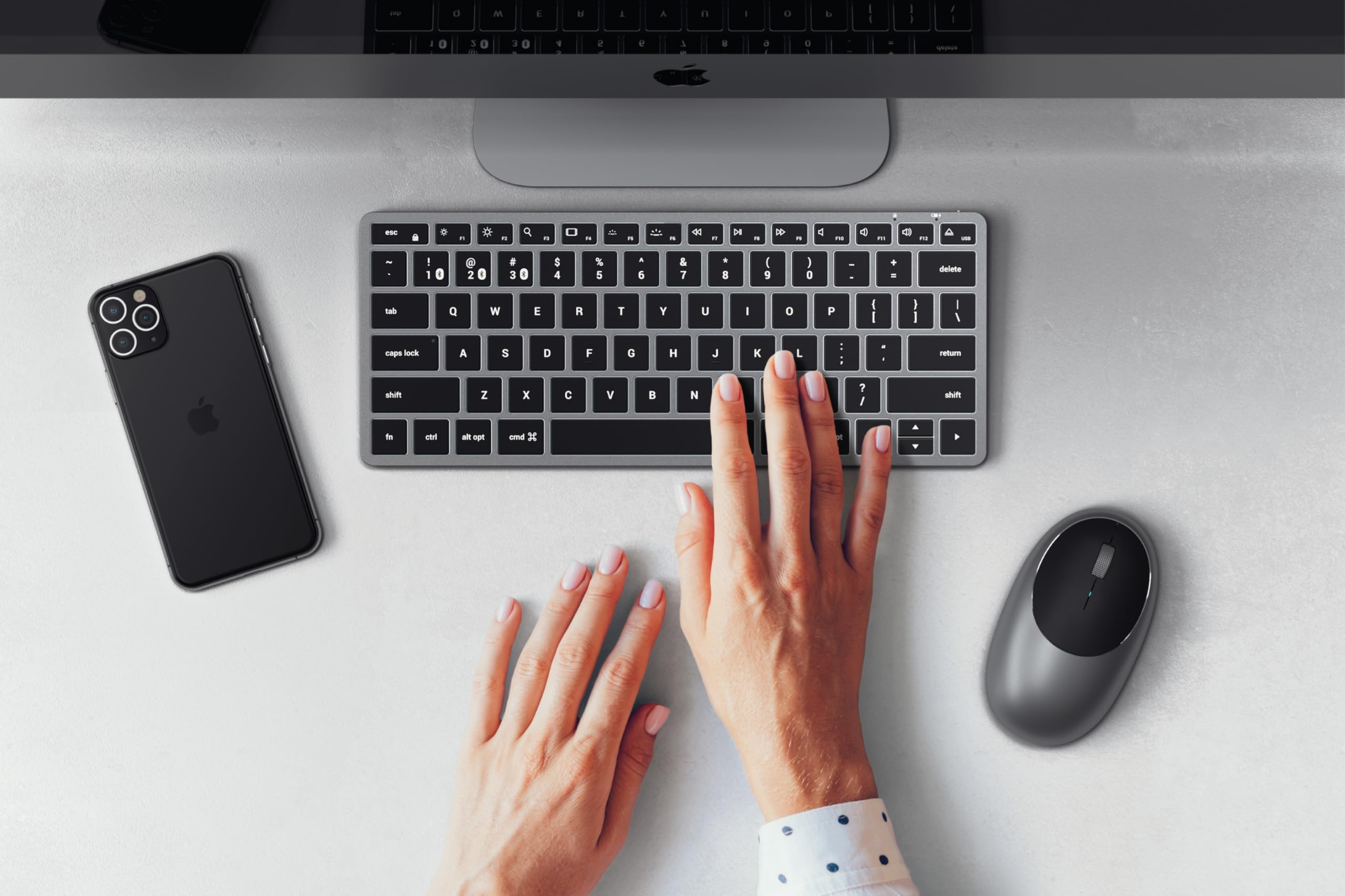Servicios al cliente
Sobre nosotros
Copyright © 2024 Desertcart Holdings Limited









⌨️ Elevate your Apple setup with the keyboard that keeps pace with your multitasking lifestyle
The Satechi Slim X1 Bluetooth Backlit Keyboard is a premium, ultra-slim keyboard designed exclusively for Apple users. Featuring a full QWERTY layout with MacOS function keys, it supports seamless Bluetooth connection to up to three devices, including MacBooks, iPads, and iPhones. Its rechargeable USB-C battery powers 10-level adjustable backlit keys, ensuring optimal visibility in any environment. Crafted with a sleek aluminum finish in space gray, it combines style and portability, backed by a 2-year limited warranty.






| Keyboard Layout | QWERTY |
| Hand Orientation | Ambidextrous |
| Button Quantity | 104 |
| Number of Sections | 1 |
| Is Electric | Yes |
| Keyboard Backlighting Color Support | Single Color |
| Power Source | Battery Powered |
| Compatible Devices | MacBook Pro M3 (14"), MacBook Pro M3 Pro (14" & 16"), MacBook Pro M3 Max (14" & 16"), MacBook Pro (13‑inch, M2, 2022), MacBook Pro (13-inch, M1, 2020), MacBook Pro (13-inch, 2020), MacBook Pro (13-inch, 2016 - 2019), MacBook Pro (14‑inch, 2023), MacBook Pro (14‑inch, 2021), MacBook Pro (16‑inch, 2023), MacBook Pro (16‑inch, 2021), MacBook Pro (16-inch, 2019), MacBook Pro (15-inch, 2016 - 2019), MacBook Air (15-inch, M3, 2024), MacBook Air (13-inch, M3, 2024), MacBook Air (15-inch, M2, 2023), MacBook Air (13-inch, M2, 2022), MacBook Air (M1, 2020), MacBook Air (Retina, 13‑inch, 2020), MacBook Air (Retina, 13-inch, 2018 - 2019), iPhone 14 Pro, iPhone 14 Pro Max, iPhone 14, iPhone 14 Plus, iPhone 13 Pro, iPhone 13 Pro Max, iPhone 13 mini, iPhone 13, iPhone SE (3rd generation), iPhone 12 Pro, iPhone 12 Pro Max, iPhone 12 mini, iPhone 12, iPhone 11 Pro, iPhone 11 Pro Max, iPhone 11, iPhone SE (2nd generation), iPhone XS, iPhone XS Max, iPhone XR, iPhone X, iPad Pro 13-inch (M4), iPad Pro 12.9-inch (6th generation), iPad Pro 12.9-inch (5th generation), iPad Pro 12.9-inch (4th generation), iPad Pro 12.9-inch (3rd generation), iPad Pro 12.9-inch (2nd generation), iPad Pro 12.9-inch (1st generation), iPad Pro 11-inch (M4), iPad Pro 11-inch (4th generation), iPad Pro 11-inch (3rd generation), iPad Pro 11-inch (2nd generation), iPad Pro 11-inch (1st generation), iPad Air 13-inch (M2), iPad Air (M2), iPad Air (5th generation), iPad Air (4th generation), iPad (10th generation), iPad (9th generation), iPad mini (6th generation), Studio Display 2022, Pro Display XDR 2019, iMac M3 (2023), iMac (24-inch, M1, 2021), iMac (Retina 4K, 21.5-inch, 2017), iMac (Retina 5K, 27-inch, 2019–2020), iMac (Retina 5K, 27-inch, 2017), iMac Pro (2017), Mac mini (2023), Mac mini (M1, 2020), Mac mini (2018), Mac Studio (2023), Mac Studio (2022), Mac Pro 2023 |
| Connectivity Technology | USB-C, Bluetooth, Wireless |
| Special Features | Ultra Slim, Travel, Backlit, Light Weight, Rechargeable |
| Number of Keys | 78 |
| Style | X1 |
| Theme | Apple/Computing |
| Color | Space Gray |
| Material | Aluminum, Plastic |
| Item Dimensions L x W x H | 11.14"L x 4.53"W x 0.47"H |
S**R
I HAVE NEVER WRITTEN AN AMAZON REVIEW
I HAVE NEVER WRITTEN AN AMAZON REVIEW despite buying things on Amazon for years.This review is true.I tried 5 different keyboards and the Satechi Slim X2 and the Satechi Compact are #6 and #7 to try.I use Mac and love Magic Keyboard but it does not have backlight.I also wanted something small but that also had the number pad (useful for Sibelius).I wanted bluetooth connectivity and a similar typing experience to the Magic Keyboard.Many offerings have the CTRL key and FN switched in position which bothers my hot key routine.The Logi MX is excellent however the backlight shuts off and is activated by motion, therefore it is constantly going out and there is no way in the software or hardware to adjust this, as of writing.I am very glad I found these Satechi keyboards because they are the only ones that do exactly what I need:- backlit- backlit stays on- all keys are in the correct place for mac- the typing experience is similar to quality of Magic Keyboard- they are compact- include number padThe Satechi Compact is slightly thicker, probably of equal thickness to Magic Keyboard, and the X2 is slightly less thick.The Compact has rounded corner keys and the X2 has the square keys like on Mac.They are both excellent so far and I am returning the other keyboards. The X2 is more like the Magic Keyboard experience because of the square corner keys but they both feel the same otherwise.I am wondering if the Compact has better battery life as it is slightly more thick. But I just got these today so only time will tell.I am keeping both - one will live on my desk and one will live in my bag for travel.Unless the battery life turns out to be terrible I am glad to find these keyboards. I highly recommend.I don't care for writing reviews but I am very satisfied that I found these after quite a search that I felt inclined to share, which is very rare for me.The X2 could basically be a Mac product if it had the logo - it really matches it well and it has backlight. Odd that Apple does not make Magic Keyboard with backlight.Thanks for reading I hope this review saves you time and toil.UPDATE 11.24.23So far so good. I have been using the Slim X2. It is very similar to Magic Keyboard.I have not charged it yet even from the package opening. I read on the Satechi website (which is good) that the battery in the X2 is 1300 mAh and the battery in the Compact is 700 mAh. This is interesting because the Compact is slightly wider and thicker.In any case, both have good build quality, especially the Compact. It has some really nice metal binding and I think the body of both are aluminum or some other metal.I will probably choose the X2 first because the keys are square it is more reminiscent of the Magic Keyboard and the battery capacity is listed as being greater, though I am not sure at this point that this is an important consideration.One final note - the backlight does fade out if not typing and is reactivated with motion of fingers on keyboard. But unlike the MX keys the fade out does not happen immediately (was really annoying) and it takes approximately 60 seconds of inactivity for the fade to occur. This is a good thing.Also if the backlit setting is at full brightness when the fade happens it does not completely fade to zero it seems, which is also good. I am very happy with the X2. The Compact is really good too. The build quality is wonderful.
D**H
good looking, nice action
I have only had this keyboard for a couple of days so I can't speak to its longevity. However it seems very well built so I have some confidence in that area.What I do like straight away is the key action. I have always used Apple keyboards and have always liked them, but this has all the good stuff and improved on them IMO. The action has a little more travel and touch which I find helps to identify when you may have struck too lightly to register a letter. In comparison Apple's keyboard has less sensitivity and gives no feedback to touch. This one has a confirming slight click to the stroke and a discreet old fashioned key sound that lets you know you have registered your key stroke correctly. I have no problem with double ket hits as others have said, rather I have had far less missed keystrokes. Bluetooth connection is fast and consistent and the ten step keyboard backlight is very useful, although I find the light leak around the sides of the keyboard a little distracting but again, no biggey. I haven't decided on using the keyboard raising pads yet and I think there could be a more elegant solution than stick on bumpers. The range of control keys for volume, apps and other things is also useful as is the ability to go wireless or tethered via the USB-C cord that also charges.If the keyboard has longevity which I think it will, its a no brainer great deal at a much better price than Apple's equivalent.
J**
Possibly the best bluetooth keyboard for mac
I was torn between the logitech mx keys mini and this satechi slim x1 for my mac and other devices.Both offer some similar features such as backlighting and multi device support. However...On the mx keys mini, device switching is on keys F1, F2, and F3, and because of that, there is no monitor brightness control there as you normally have on a mac keyboard. On the satechi, they put multi device switching on keys 1, 2, and 3, and you hold the FN button down and press one of those to switch. This way they were able to keep the monitor brightness controls and other F-keys virtually identical to what we are used to having on our macs, including back and forward buttons for music. The Mx keys also doesn't have back and forward keys for music because they opted for other buttons there.So basically this one is more true to the mac key layout. You CAN, in the logi software remap some of the F keys to compensate for what's missing, but on the satechi there are no compromises to be made.The satchi is MUCH lighter, so if you ever lounge back in your chair and type from your lap, this one is more comfortable to pull off of your desk.There is also an issue with the mx keys mini, where on an initial bootup or restart, it doesn't pair until after you enter your passkey. Meaning you need to use another keyboard, or if you're using it with a laptop, use the laptop keyboard for that first login. That's wild, because the satechi works on the initial login without issue. It takes a second or two before the keyboard pairs on startup, but it does work for that initial login. So whatever reason logitech gives as an excuse for that, satechi seems to have made it work.The backlight stays on around a minute but dims after a few seconds, but overall works nicely. The MX keys mini now allows users to set anywhere from 5 seconds to 30 minutes of backlight though - which I believe is a new feature. This comes at the cost of battery and I normally don't need more than a minute of idle backlight anyways.Overall/TLDR:The satechi is light weight, closely resembles the true mac key layout, quickly switches between three devices, can be used corded, and can be used for an initial password screen on your mac unlike the mx keys mini by logitech. The logitech looks nicer and feels a bit higher quality, but the drawbacks still put this one ahead in my opinion.I will say though, that my power switch broke and fell into the keyboard so it is stuck on, and it took less than a month of use for the keys to get shiny from use even though I try to keep it clean. That is inevitable for any keys on a keyboard, but it happened very fast on this one, and those are the reasons I took a star off.
Trustpilot
Hace 1 semana
Hace 2 días